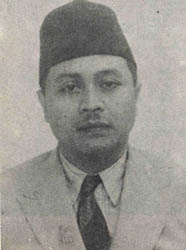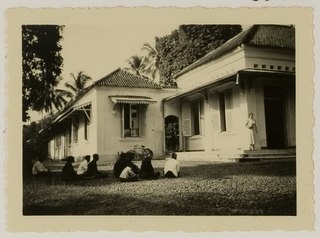Related Research Articles

Djamaluddin Adinegoro was an Indonesian press pioneer. He is known as a reporter, writer, and political analyst. Through his writing in various newspapers, Adinegoro has made a great contribution in developing journalism and the Indonesian language. His name was immortalized as a journalism award in Indonesia: the Adinegoro Award. Djamaluddin was a younger half-brother of Muhammad Yamin.

Indonesian literature is a term grouping various genres of South-East Asian literature.
Balai Pustaka is the state-owned publisher of Indonesia and publisher of major pieces of Indonesian literature such as Salah Asuhan, Sitti Nurbaya and Layar Terkembang. Its head office is in Jakarta.

Jalan Tak Ada Ujung is an Indonesian novel by Mochtar Lubis first published by Balai Pustaka in 1952. It takes place during the Indonesian war of independence and tells the story of Guru Isa, a schoolteacher who assists the guerrilla freedom fighters yet lives in fear.

Prof. Mr. Abdoel Gaffar Pringgodigdo was the Minister of Justice of Indonesia from 21 January to 6 September 1950.

Poedjangga Baroe was an Indonesian avant-garde literary magazine published from July 1933 to February 1942. It was founded by Armijn Pane, Amir Hamzah, and Sutan Takdir Alisjahbana.
Darah Muda is a 1927 novel written by Indonesian writer Djamaluddin Adinegoro and published by Balai Pustaka. It is one of few Indonesian novels from the period in which the protagonists succeed in love.

Zuber Usman was an Indonesian teacher and writer, known as an early pioneer of Indonesian literary criticism. Born in Padang, West Sumatra, he was educated in Islamic schools until 1937, after which he became a teacher. Dabbling in writing short stories during the Japanese occupation of the Dutch East Indies and the ensuing revolution, for the rest of his life Usman focused on teaching and writing about literature.

Sariamin Ismail was the first female Indonesian novelist to be published in the Dutch East Indies. A teacher by trade, by the 1930s she had begun writing in newspapers; she published her first novel, Kalau Tak Untung, in 1933. She published two novels and several poetry anthologies afterwards, while continuing to teach and – between 1947 and 1949 – serving as a member of the regional representative body in Riau. Her literary works often dealt with star-crossed lovers and the role of fate, while her editorials were staunchly anti-polygamy. She was one of only a handful of Indonesian women authors to be published at all during the colonial period, alongside Fatimah Hasan Delais, Saadah Alim, Soewarsih Djojopoespito and a few others.

Kalau Ta' Oentoeng is a 1933 novel written by Sariamin Ismail under the pseudonym Selasih. It was the first Indonesian novel written by a woman. Written in a flowing style heavily dependent on letters, the novel tells the story of two childhood friends who fall in love but cannot be together. It was reportedly based on the author's own experiences. Although readings have generally focused on the novel's depiction of an "inexorable fate", feminist and postcolonial analyses have also been done.

Riau-Lingga Sultanate, also known as the Lingga-Riau Sultanate, Riau Sultanate or Lingga Sultanate was a Malay sultanate that existed from 1824 to 1911, before being dissolved following Dutch intervention.

Kawan Bergeloet is a collection of short stories written by Soeman Hs and first published by Balai Pustaka in 1941. It contains twelve stories, seven of which were previously published in the magazine Pandji Poestaka, as well as an introduction by Sutan Takdir Alisjahbana. These stories are generally humorous in nature, and presented with a diction that shows strong east Sumatran influences.

Soeman Hasibuan better known by his pen name Soeman Hs, was an Indonesian author recognized for pioneering detective fiction and short story writing in the country's literature. Born in Bengkalis, Riau, Dutch East Indies, to a family of farmers, Soeman studied to become a teacher and, under the author Mohammad Kasim, a writer. He began working as a Malay-language teacher after completing normal school in 1923, first in Siak Sri Indrapura, Aceh, then in Pasir Pengaraian, Rokan Hulu, Riau. Around this time he began writing, publishing his first novel, Kasih Tak Terlarai, in 1929. In twelve years he published five novels, one short story collection, and thirty-five short stories and poems.
Suwarsih Djojopuspito, in pre-1940 spelling Soewarsih Djojopoespito, was an Indonesian author, regarded as one of the most important Indonesian feminist writers, publishing from the 1940s to the 1970s. Among her most well-known works are the semi-autobiographical novel Buiten het gareel (1940) and the short story collection Empat Serangkai (1954). She was among the vanguard of early feminist authors in Indonesia that preceded the New Order, and was one of the first female writers to be published by the state publishing house Balai Pustaka.

Saadah Alim (1897–1968) was a writer, playwright, translator, journalist and educator in the Dutch East Indies and in Indonesia after independence. She was one of only a handful of Indonesian women authors to be published during the colonial period, alongside Fatimah Hasan Delais, Sariamin Ismail, Soewarsih Djojopoespito and a few others. She is known primarily for her journalism, her collection of short stories Taman Penghibur Hati (1941), and her comedic play Pembalasannya (1940).

Sri Koesnapsijah was a Javanese language writer and activist of the Dutch East Indies and Indonesia who was among the generation of Indonesian women writers active in the 1930s. She was known for her short stories and articles which she published in the magazine Panjebar Semangat in the 1930s and 1940s, where she was also an assistant editor. After Indonesian independence she was active in the Communist Party-affiliated Gerwani movement, and was briefly a representative of the Communist Party in the Jakarta-area consultative body DPR-GR. She was arrested in late 1965 during the anti-communist repression of the Transition to the New Order and imprisoned without charge for the following decade.
Koestijah, who commonly published as Rara Koestijah was a Javanese language writer of the Dutch East Indies known primarily for the short stories she published in the 1930s and early 1940s in the magazine Panjebar Semangat. Her short stories dealt with themes of interpersonal moral conflicts, class difference, and marriage.
Censorship in the Dutch East Indies was significantly stricter than in the Netherlands, as the freedom of the press guaranteed in the Constitution of the Netherlands did not apply in the country's overseas colonies. Before the twentieth century, official censorship focused mainly on Dutch-language materials, aiming at protecting the trade and business interests of the colony and the reputation of colonial officials. In the early twentieth century, with the rise of Indonesian nationalism, censorship also encompassed materials printed in local languages such as Malay and Javanese, and enacted a repressive system of arrests, surveillance and deportations to combat anti-colonial sentiment.

The Liep Nio was a Chinese Indonesian writer and playwright active in the 1930s in the Dutch East Indies. Little is known about her life aside from the fact that she was a Peranakan Chinese woman from Purbalingga in Central Java; she was probably born in the early twentieth century. She was part of the first generation of Indonesian women who to appear in print, which was almost unheard of before the 1930s; the first short writings by Native Indonesian and Indonesian Chinese women are thought to have appeared in newspapers in the 1910s and 1920s, but few were published in book form until the 1930s. The Liep Nio published poems, novels, plays, and short stories in literary magazines such as Tjerita Roman, Liberty, and Djawa Tengah Review.

Letters of a Javanese Princess is a posthumous book of letters by the Dutch East Indies women's rights activist and intellectual Kartini. The letters, which were written in Dutch, reveal Kartini's views on society and modern life, and were collected by one of Kartini's correspondents Jacques Henrij Abendanon and published in 1911. They have since been translated into a number of other languages, including an English language version in 1920 and a Malay language version published by Balai Pustaka in 1922. The book became an important symbol both for liberal Dutch colonial policy and for Indonesian nationalism.
References
- ↑ Oey-Gardiner, Mayling; Bianpoen, Carla (2000). Indonesian women : the journey continues. Canberra: Australian National University, Research School of Pacific and Asian Studies. pp. 27–45. hdl:2027/mdp.39015053108489. ISBN 9780646392301.
- 1 2 3 4 5 6 7 8 "Hamidah (1915—1953)". Ensiklopedia Sastra Indonesia (in Indonesian). Badan Pengembangan dan Pembinaan Bahasa, Kementerian Pendidikan dan Kebudayaan Republik Indonesia. Retrieved 31 October 2020.
- ↑ "Drang naar Westersch Onderwijs". Algemeen handelsblad voor Nederlandsch-Indië (in Dutch). 1929-07-16.
- ↑ "SEMANGAT MOEDA". Overzicht van de Inlandsche en Maleisisch-Chineesche pers (in Dutch). No. 28. 1929-01-08.
- ↑ "Sejarah Ahmadiyah di Jakarta". Jamaah Muslim Ahmadiyah Indonesia (in Indonesian). Retrieved 1 November 2020.
- ↑ Koning, Juliette; Nolten, Marleen; Rodenburg, Janet; Saptari, Ratna (2013). Women and Households in Indonesia: Cultural Notions and Social Practices. Routledge. pp. 59–60. ISBN 9781136824241.
- ↑ Bianpoen, Carla; Oey-Gardiner, Mayling (2000). Indonesian women : the journey continues. Canberra: Australian National University, Research School of Pacific and Asian Studies. pp. 29–30. ISBN 9780646392301.
- ↑ "Formats and Editions of Kehilangan mestika [WorldCat.org]". www.worldcat.org. Retrieved 1 November 2020.
- ↑ "Gedung Hamidah Disewa Pizza Hut, Arsitek Hongky Listiyadhi Nilai Akan Lebih Bermanfaat". Bangka Pos (in Indonesian). 2020-03-10. Retrieved 1 November 2020.